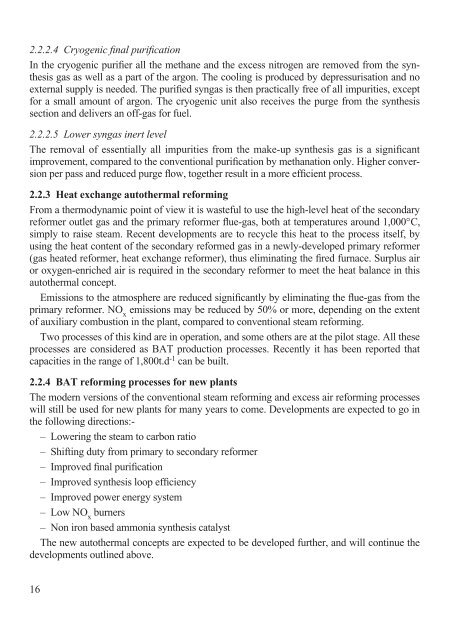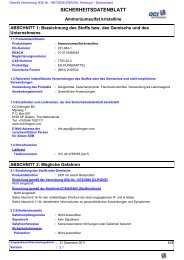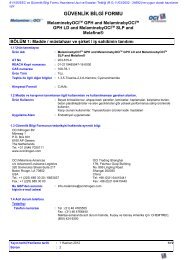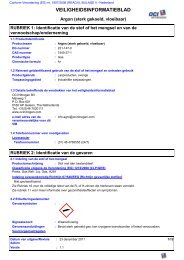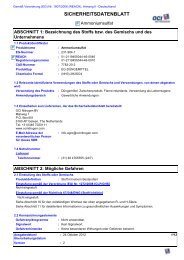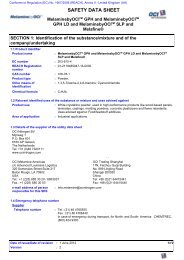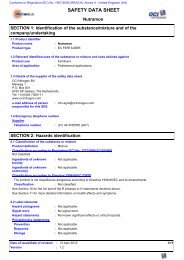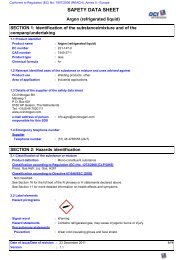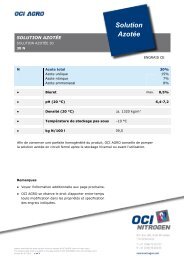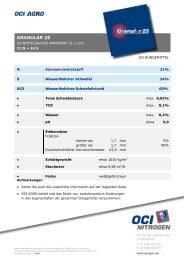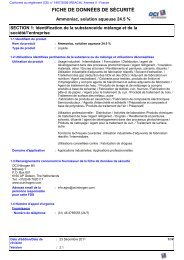PRODUCTION OF AMMONIA - OCI Nitrogen
PRODUCTION OF AMMONIA - OCI Nitrogen
PRODUCTION OF AMMONIA - OCI Nitrogen
Create successful ePaper yourself
Turn your PDF publications into a flip-book with our unique Google optimized e-Paper software.
2.2.2.4 Cryogenic final purification<br />
In the cryogenic purifier all the methane and the excess nitrogen are removed from the synthesis<br />
gas as well as a part of the argon. The cooling is produced by depressurisation and no<br />
external supply is needed. The purified syngas is then practically free of all impurities, except<br />
for a small amount of argon. The cryogenic unit also receives the purge from the synthesis<br />
section and delivers an off-gas for fuel.<br />
2.2.2.5 Lower syngas inert level<br />
The removal of essentially all impurities from the make-up synthesis gas is a significant<br />
improvement, compared to the conventional purification by methanation only. Higher conversion<br />
per pass and reduced purge flow, together result in a more efficient process.<br />
2.2.3 Heat exchange autothermal reforming<br />
From a thermodynamic point of view it is wasteful to use the high-level heat of the secondary<br />
reformer outlet gas and the primary reformer flue-gas, both at temperatures around 1,000°C,<br />
simply to raise steam. Recent developments are to recycle this heat to the process itself, by<br />
using the heat content of the secondary reformed gas in a newly-developed primary reformer<br />
(gas heated reformer, heat exchange reformer), thus eliminating the fired furnace. Surplus air<br />
or oxygen-enriched air is required in the secondary reformer to meet the heat balance in this<br />
autothermal concept.<br />
Emissions to the atmosphere are reduced significantly by eliminating the flue-gas from the<br />
primary reformer. NO x emissions may be reduced by 50% or more, depending on the extent<br />
of auxiliary combustion in the plant, compared to conventional steam reforming.<br />
Two processes of this kind are in operation, and some others are at the pilot stage. All these<br />
processes are considered as BAT production processes. Recently it has been reported that<br />
capacities in the range of 1,800t.d -1 can be built.<br />
2.2.4 BAT reforming processes for new plants<br />
The modern versions of the conventional steam reforming and excess air reforming processes<br />
will still be used for new plants for many years to come. Developments are expected to go in<br />
the following directions:-<br />
– Lowering the steam to carbon ratio<br />
– Shifting duty from primary to secondary reformer<br />
– Improved final purification<br />
– Improved synthesis loop efficiency<br />
– Improved power energy system<br />
– Low NO x burners<br />
– Non iron based ammonia synthesis catalyst<br />
The new autothermal concepts are expected to be developed further, and will continue the<br />
developments outlined above.<br />
16


